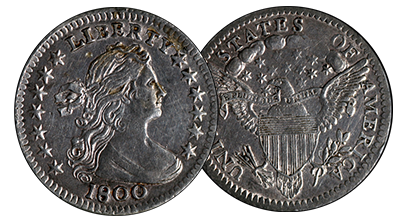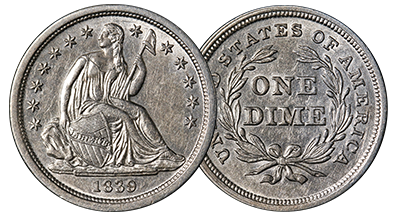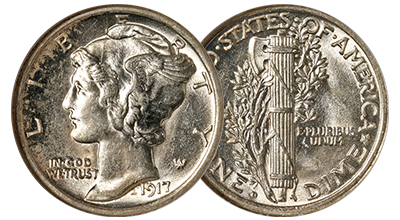There are no products listed under this category.
US Dime For Sale
Dime is one of the oldest coins in the US. In 1792, the Coinage Act was established, which saw the founding of the National Mint in Philidelphia and the integration of cents, dimes, and quarters. The National Mint issued the first circulating coins in 1793.
Dimes have become a must-have for coin collectors, and Bullion Shark is proud to offer the highest quality Half Dimes, Draped Bust Dimes, Capped Bust Dimes, Seated Liberty Dimes, Barber Dimes, Mercury Dimes, and Roosevelt Dimes.
Dime - America's Numismatic Heritage
The dime, a fundamental piece of the United States currency system, stands as a testament to the rich numismatic heritage of America. This ten-cent coin, despite its modest size, carries a weighty legacy of the nation's history, artistry, and evolution in coinage. The "Dime" category encompasses a diverse array of designs, each marking a distinct period in American history and reflecting the changing face of the nation.
Historical Journey of a Dime
The journey of the dime began in 1796, introduced by the Coinage Act of 1792, which laid the foundation for the United States Mint and its coinage. The first dimes featured the Draped Bust design, symbolizing the young nation's elegance and emerging identity. As decades passed, the dime evolved through several designs, including the Capped Bust, Seated Liberty, Barber, Mercury, and the current Roosevelt dime. Each design iteration not only offers a glimpse into the era it represents but also showcases the advancements in minting technologies and artistic trends of the time.
Artistic and Cultural Significance of a Dime
The dime has served as a canvas for some of the most celebrated designs in American coinage. The Mercury dime, with its iconic depiction of Liberty donning a winged cap, epitomizes the artistic and cultural vibrancy of the early 20th century. Similarly, the Roosevelt dime honors President Franklin D. Roosevelt's legacy and his efforts to lead the nation through challenging times. These designs are not just mere currency; they are miniature artworks that capture the essence of America's ideals, challenges, and achievements.
Collecting Dime coins
Collecting dimes is a journey through America's past, offering numismatists and enthusiasts a chance to explore the nation's history in a tangible form. From rare and sought-after pieces like the 1894-S Barber dime to the widely recognized Roosevelt dimes, collectors can delve into the nuances of mint marks, rarities, and historical contexts. Each dime tells a story, whether it's a reflection of America's industrial growth, wartime resilience, or commemorative milestones.
Buy Rare Dimes Online
Rare dimes are highly sought after by numismatists for their historical significance, scarcity, and unique stories. Here's a list of some of the most notable rare dimes in U.S. coinage, each with its own place in numismatic lore:
1. 1894-S Barber Dime
- Why It's Rare: Only 24 were minted, and just a handful survive today. Its rarity is attributed to a small production for assay purposes.
- Notable Features: Part of the Barber coinage, named after its designer, Charles E. Barber.
2. 1874-CC Liberty Seated Dime
- Why It's Rare: The Carson City Mint produced a limited number of these dimes, making them rare, especially in higher grades.
- Notable Features: Features the Liberty Seated design, which is common across several denominations of the era.
3. 1916-D Mercury Dime
- Why It's Rare: The 1916-D is the key date for the Mercury Dime series, with a mintage of only 264,000, making it highly sought after by collectors.
- Notable Features: Features the iconic Winged Liberty Head design, often mistaken for the Roman god Mercury, hence the name.
4. 1942/1 Mercury Dime
- Why It's Rare: This overdate error occurred when a 1942 die was stamped over a 1941 die, creating a rare and valuable variety.
- Notable Features: Part of the Mercury Dime series, this error is found in both the Philadelphia and Denver minted coins, with the Denver mint mark being particularly rare.
5. 1829 Curl Base "2" Liberty Seated Dime
- Why It's Rare: A unique variety within the Liberty Seated series, characterized by the curl base of the "2" in the date.
- Notable Features: Early example of the Liberty Seated design, which features Liberty sitting on a rock.
6. 1796 Draped Bust Dime
- Why It's Rare: As one of the first dimes minted by the United States, its low mintage makes it a prized piece for collectors.
- Notable Features: Features the Draped Bust design, which was among the earliest designs for U.S. coinage.
7. 1798/7 Draped Bust Dime
- Why It's Rare: This overdate coin, where a 1798 date was stamped over a 1797 date, is a rarity in the early American coinage.
- Notable Features: Part of the Draped Bust series, which features a representation of Liberty with flowing hair and a draped bust.
8. 1872-CC Liberty Seated Dime
- Why It's Rare: Another rare Carson City minted coin, with a very low mintage making it highly collectible.
- Notable Features: Bears the "CC" mint mark and the Liberty Seated design.
9. 1871-CC Liberty Seated Dime
- Why It's Rare: Like other Carson City minted coins, its low mintage numbers contribute to its rarity and desirability among collectors.
- Notable Features: Part of the Liberty Seated dime series minted in Carson City.
10. 1921 Mercury Dime
- Why It's Rare: With low mintages for both the Philadelphia and Denver mints, the 1921 and 1921-D Mercury dimes are among the scarcest in the series.
- Notable Features: Last year of significantly low mintages for the Mercury Dime series before production numbers increased.
Half Dime
The Half Dime was minted in 1792, in circulation until 1793, and was worth the equivalent of five cents.
The Half Dime is widely considered the first coin ever struck under the coinage act of 1792. However, this isn't universally recognized as its unknown whether the coin was intended to be circulated or was an experimental measure.
It is speculated that only 2,000 to 3,500 of these coins were produced. The Half Dime was designed by the engraver Robert Birch, and it's obverse side featured Liberty facing left, while the verse side portrays a flying eagle.
Half Dimes have an estimated mintage of 1500-2000.
Draped Bust Dime
The Draped Bust Dime was designed by artist Gilbert Stuart and ran from 1796 until 1805.
When the Draped Bust Dime was introduced, it featured Liberty with flowing hair and 15 stars surrounding her. However, in 1797, 16-star coins were also produced, the additional star represented the newly added state of Tennessee. The Mint also began circulating 13-star varieties, as they realized they couldn't continue adding stars as new states joined the union.
Until 1797, the reverse side of the Draped Bust Dime featured a small eagle surrounded by a wreath. This changed in 1800 as the Heraldic Eagle design was introduced.
The mintage of the Draped Bust Dimes ranged from 22,135 to 27,550 in the first series. However, the mintage increased to 165,000 in its final year.
Capped Bust Dime
Between 1806 and 1828, dimes ceased to be produced. However, 1829 saw their return with the Capped Bust Dime. Chief Engraver William Kneass developed the design for the Capped Bust Dime and his design remained the same for the coin's entire run, which lasted until 1837.
The Capped Bust Dime's mintage ranged from 871,000 in its final year and 2,760,000 in 1835.
Seated Liberty Dime
The 1837-1891 Seated Liberty Dime was the last seated liberty coin to be produced. These dimes feature Liberty seated on a rock holding a shield on the obverse side and a wreath surrounding the words "One Dime" on the reserve side.
In 1838, a semicircle of 13 stars was added to the obverse side. The design was changed again in 1853 as small arrows were added to signify a reduction in silver. However, these arrows were dropped again in 1856, and in 1860 the semicircle of stars was replaced with an inscription reading "United States of America."
The seated liberty was designed by portraitist Christian Gobrecht. The mintage of Seated Liberty Half Dimes ranges from 6,000 to 13,210,020.
Barber Dime
The Barber Dime was designed by Charles Barber, who was the United States' chief engraver at the time. These coins were produced between 1892 and 1916 and consisted of 90% silver and 10% copper.
The Barber Dime depicts Liberty facing right, wearing a crown fashioned from an olive branch on the obverse side. The words "United States of America" also surround her head. The reverse of the coin features a wreath of corn and oak leaves surrounded by the words "One Dime."
The mintage of the Barber Dime ranges from 440,000 to 22,220,000.
Mercury Dime
The Mercury Dime is a ten-cent coin that was in circulation from 1916 until 1945.
Adolph Weinman designed the coin and chose to depict young Liberty wearing her Phrygian cap on the obverse side. The coin gained its name as many confused this depiction with the image of the Roman god Mercury. The reverse side features a fasces and an olive branch.
Mercury Dimes contain 0.07234 troy ounces of silver. The lowest mintage of Mercury Dimes occurred in 1916, with only 264,000 struck. While the highest mintage year was 1944, with 231,410,000 coins struck.
Roosevelt Dime
After the death of President Roosevelt in 1945, the Roosevelt Dime quickly replaced the Mercury Dime in 1946. The Roosevelt Dime is the current dime of the United States.
John R. Sinnock designed both sides of the coin, the obverse featuring a portrait of Franklin Roosevelt and the reverse side depicting a torch, an olive branch, and an oak branch.
The mintage of Roosevelt Dimes ranges from 12,450,181 to 2,244,007,320.
Dimes FAQ
The current figure depicted on the U.S. dime is President Franklin D. Roosevelt. His likeness has been featured on the dime since 1946, the year after his death. This change was made in honor of his leadership during the Great Depression and World War II, as well as his founding of the March of Dimes, which originally aimed to combat polio, a disease Roosevelt himself suffered from. The Roosevelt dime design was introduced to commemorate his contributions and has remained in circulation since then.
A US dime weighs 2.268 grams (approximately 0.08 ounces). This has been the standard weight since 1965, when the dime's composition was changed to a clad construction of copper and nickel.
A US dime has a face value of 10 cents. However, the value of a dime can be significantly higher for collectors, depending on factors such as its age, rarity, condition, and any historical significance. For example, rare dimes like the 1894-S Barber Dime can fetch hundreds of thousands to over a million dollars at auction. For general circulation coins, the value remains 10 cents.
A dime is a coin worth ten cents or one-tenth of a United States dollar. It is the smallest in diameter and the thinnest of all U.S. coins currently minted for circulation. The dime has been a part of the U.S. currency system since the Coinage Act of 1792, although the first dimes were not produced until 1796. The current design features the portrait of President Franklin D. Roosevelt on the obverse (front) side, in honor of his leadership and the establishment of the March of Dimes, originally created to help fight polio. The reverse (back) side of the coin features a torch, olive branch, and oak branch, symbolizing liberty, peace, and victory respectively.








